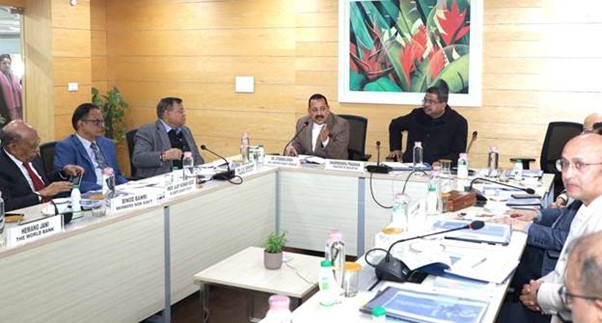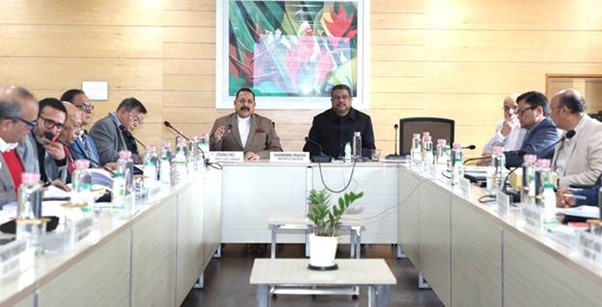Dr. Jitendra Singh Union Minister Champions Early Industry Collaboration & Inclusive Innovation for Start-Up Sustainability; Envisions AIM 2.0 as a Catalyst for India’s Global Leadership in Innovation
(Judicial Quest News Network)
In a compelling call for action, Dr. Jitendra Singh, Union Minister of State for Science and Technology, Earth Sciences, and the Prime Minister’s Office, laid out his vision for the future of India’s innovation ecosystem during the Atal Innovation Mission (AIM) High-Level Committee Meeting at NITI Aayog. Advocating for a stronger industry linkage to sustain startups, Dr. Singh urged the creation of a hybrid framework that maintains AIM’s creative independence while fostering the necessary collaborations for long-term success.
Speaking at the meeting, Dr. Singh emphasized the necessity of early industry involvement to ensure that startups are equipped for sustainable growth. He proposed a collaborative funding model where industry and government work in tandem, each bearing shared responsibility and accountability in the innovation process. According to him, such a joint investment model would not only ensure mutual commitment but also foster a vibrant innovation ecosystem based on cooperation and shared stakes. “When industry and government join hands, it lays the foundation for a sustainable ecosystem, and this collaboration is vital for the survival and growth of startups,” he asserted.
Highlighting AIM 2.0 as a critical stepping stone in India’s journey to becoming a global innovation powerhouse, the Minister underscored its potential to transform the entrepreneurial landscape by enhancing public-private partnerships (PPP) and integrating industry linkages. He lauded the achievements of AIM 1.0, noting that its success had been catalyzed by transformative policies introduced under Prime Minister Narendra Modi’s leadership since 2014. “The talent was always there, but the policies that followed enabled initiatives like AIM to flourish,” he noted, celebrating the tangible impact of these forward-thinking policies.

One of the key aspects of Dr. Singh’s speech was his call for a framework that would help measure the impact of startups, not only by their innovative outputs but also by their contribution to livelihood generation. He proposed creating an aspirational framework to assess startups on various indices, such as publication impact, startup viability, and job creation. “Ultimately, the success of our innovation ecosystem must be measured by the number of livelihoods it creates. If we fall short in this aspect, we risk limiting the true potential of our initiatives,” he explained.
Further elaborating on the importance of inclusivity, Dr. Singh highlighted the need for a language-neutral approach to innovation. Recognizing India’s diverse linguistic landscape, he stressed the importance of ensuring equitable opportunities for all, irrespective of their region or native language. He pointed out that translation challenges could inadvertently create barriers for participants in regional areas, and thus, stakeholders must actively address these issues to ensure a truly inclusive innovation ecosystem.
In the context of India’s growing scientific achievements, Dr. Singh reflected on significant breakthroughs such as the successful trials of gene therapy, which have garnered attention from top international journals like the New England Journal of Medicine. He emphasized that such accomplishments, combined with a commitment to global standards, will inspire greater confidence in India’s research capabilities and provide a solid foundation for the country’s global credibility in the scientific community.
Closing his remarks, Dr. Singh expressed his optimism about the future of the Atal Innovation Mission. He envisions AIM 2.0 as a pivotal step toward AIM 3.0 and beyond, setting the stage for India to take its place as a global leader in innovation. “Our journey in innovation is far from over. With strong partnerships, an expanded ecosystem, and a focus on creating tangible impact, we are well on our way to positioning India as a global leader in innovation,” he declared.
The AIM High-Level Committee Meeting, which brought together policymakers, industry leaders, and academic experts, was an important forum for charting the future direction of AIM 2.0. With shared commitment to advancing India’s innovation agenda, the meeting marked a crucial step toward strengthening India’s position in the global innovation landscape.


